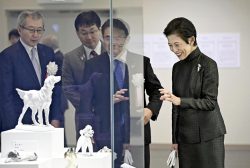
Associate Prof. Kojiro Hirose touches a sculpture of a Japanese crested ibis at the National Museum of Ethnology in Suita, Osaka Prefecture
11:13 JST, February 10, 2022
There has been a lot of attention paid to the idea of allowing visitors to touch artworks in museums. For the visually impaired, the sense of touch is an important means of perceiving things, and the aim is to include it in art appreciation.
One such project is facing difficulties from the standpoint of preventing the spread of the coronavirus, but the organizers have proceeded through trial and error.
From September to November, the National Museum of Ethnology in Suita, Osaka Prefecture, held a special exhibition called “Universal Museum: Exploring the New Field of Tactile Sensation.”
It is common for museums and art galleries to have signs everywhere saying, “Please do not touch the artworks,” but this special exhibition featured artworks that could be touched and enjoyed by anyone, regardless of whether they had a visual impairment.
Exhibits included a replica of the head of the Buddha at Kohfukuji Temple and a 3D map of the area around Mt. Fuji, and visitors could feel the texture, size and unevenness of the exhibits with their hands.
About 27,000 people came to the show, and visitors who answered a questionnaire had many favorable comments, such as “Touching is important” and “Thank you for holding this event at this time [during the pandemic].”
Postponed for a year
The special exhibition was scheduled to be held last autumn but was postponed for a year due to the virus. There were concerns about holding the exhibition this autumn as well, with some people saying, “Holding an exhibition where an unspecified number of people touch artworks may be criticized by the public.”
However, organizers decided to go ahead after they set up lots of hand sanitizer dispensers, strengthened ventilation, limited the number of visitors and generally took all possible measures to prevent infection.
In November, when the infection situation improved, in-person lectures were permitted and there was a queue for admission.

A derivative work of Pieter Bruegel the Elder’s “The Tower of Babel” created by Kanade Ikematsu
Associate Prof. Kojiro Hirose of the National Museum of Ethnology, who was in charge of the event, is himself blind. He did not initially anticipate the spread of the coronavirus, but as a visually impaired person, he could not overlook the spread of “noncontact” standards.
“I felt a sense of danger, as if I were being denied my own existence. I wanted to promote the value of touch and the richness of the world through this special exhibition,” he said.
Making paintings 3D
At the special exhibition, students from Kyoto City University of Arts exhibited derivative works that were 3D versions of famous paintings. Kanade Ikematsu created a 3D version of “The Tower of Babel” by Pieter Bruegel the Elder, saying, “I used multiple layers of clay so that the hardness of the tower changes from the bottom to the top, making it easier to understand the skyscraper through a sense of touch.”
Riri Inaoka, who took on the challenge of creating a 3D version of Edvard Munch’s “The Scream,” said, “Through my creation, I was able to learn a sense of touch that I had never had before.”

Courtesy of the National Museum of Ethnology
Hirose said, “I would like to take on the challenge of creating a facility where people can experience the fun and value of ‘touch’ rather than ‘tactile appreciation’ to experience the feelings of the visually impaired.”
New form of appreciation
The law for the promotion of cultural and artistic activities by persons with disabilities, which requires the national and local governments to improve facilities, came into effect in 2018, enabling disabled people to further enjoy cultural and artistic facilities. But such efforts are still in progress.
According to the fiscal 2019 survey conducted by the Japanese Association of Museums, only 43% of the 4,178 facilities nationwide had installed elevators for disabled visitors, while 13% said they provided sign language and other support for the hearing impaired. Only 7% provided Braille explanations for the visually impaired.
In addition to such barrier-free improvements, there are also moves to find ways to make art more enjoyable for the visually impaired. Since 2017, the National Museum of Modern Art, Kyoto has been conducting a project titled “Opening the Senses.”
The museum has been producing special art educational materials and holding group appreciation sessions with the visually impaired, exploring a new form of art appreciation in a three-way partnership of visually impaired people, artists and the museum itself.
Saki Matsuyama, the museum’s special researcher in charge of the project, said: “The senses at the fingertips of the visually impaired are very sensitive. I’ve realized again how rich the world of ‘touch’ is after hearing their impressions of the works.”
"Culture" POPULAR ARTICLE
-

Van Cleef & Arpels Dazzles with Art Deco Artisanry at Tokyo Exhibit
-

Disney’s ‘Twisted-Wonderland’ Animated Series Puts Villains in Spotlight: New Show Features School Inspired by Classic Disney Films
-

Japan Plans to Distribute Manga Overseas Via New Platform
-

Ayumi Hamasaki’s Shanghai Concert Canceled Day Before Schedule as Part of Beijing Backlash
-

‘The World Masterpiece Theater Series’ Celebrates 50 Years; Animator Looks Back on Creating Anime Classics
JN ACCESS RANKING
-

Tokyo Economic Security Forum to Hold Inaugural Meeting Amid Tense Global Environment
-

Keidanren Chairman Yoshinobu Tsutsui Visits Kashiwazaki-Kariwa Nuclear Power Plant; Inspects New Emergency Safety System
-

Imports of Rare Earths from China Facing Delays, May Be Caused by Deterioration of Japan-China Relations
-

University of Tokyo Professor Discusses Japanese Economic Security in Interview Ahead of Forum
-

Japan Pulls out of Vietnam Nuclear Project, Complicating Hanoi’s Power Plans

























